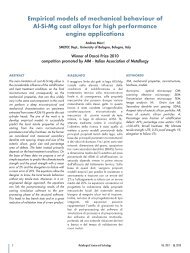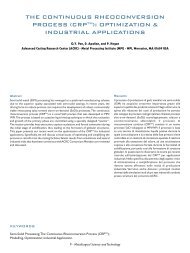PDF, about 5Mb - Teksid Aluminum
PDF, about 5Mb - Teksid Aluminum
PDF, about 5Mb - Teksid Aluminum
You also want an ePaper? Increase the reach of your titles
YUMPU automatically turns print PDFs into web optimized ePapers that Google loves.
1. INTRODUCTION<br />
Lightweight constructions are becoming more and<br />
more important for the automotive industries due<br />
to increase of fuel prices and legislative<br />
requirements like CAFÉ in the US, and the directive<br />
or the control of CO 2 emissions in the EU [1,2].<br />
Magnesium alloys for their unique combination of<br />
light weight, high specific strength and stiffness and<br />
high recycling capability are candidate to replace<br />
steel, iron and, in some cases, also aluminum parts.<br />
The growing interest in magnesium alloys is<br />
expected to increase in the next years [3]. The<br />
use of components manufactured via die-, sand-,<br />
mould- and rheo-casting is fairly well introduced<br />
in a wide number of applications which are ranging<br />
from steering wheels, instrumental panels, gear box<br />
housing and even to hybrid engine blocks. The<br />
scenario for the automotive industry is that the<br />
use of magnesium alloys for many components,<br />
mainly as castings, is further expanding in the short<br />
term, whereas the application in body and chassis<br />
components, including sheet and extrusions, is<br />
anticipated in the medium term [4].<br />
A driving force for the introduction of wrought<br />
alloys is their property enhancement, since casting<br />
alloys are affected by porosity, which would be of<br />
particular importance for structural and crashrelevant<br />
parts. Initial applications for this category<br />
are expected for extrusions and forgings, to be<br />
followed by sheets. These requirements may<br />
address researches towards the modification of<br />
known alloys as well as the development of new<br />
ones aiming at improving both mechanical<br />
performances, also by ageing (T6), and high<br />
temperature stability. The growing interest in use<br />
of magnesium alloys is expected to increase in the<br />
next years, and to be sustained by research [5].<br />
From recent magnesium alloys conferences [6], the<br />
following items stand out as limiting or retarding<br />
factors for the use of wrought alloys: 1) poor cold<br />
forming properties; 2) limited number of wrought<br />
alloys and lack of processing data. As far as the<br />
item 1) is concerned, it is important to note that<br />
magnesium alloys are difficult to work at low<br />
temperature (







